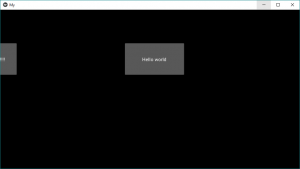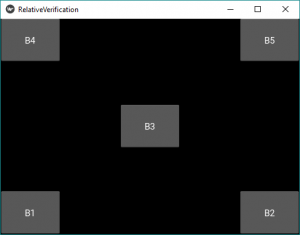Python| Kivy 中的相对布局
Kivy 是Python中一个独立于平台的 GUI 工具。因为它可以在Android、IOS、Linux和Windows等平台上运行。它基本上是用来开发Android应用程序的,但这并不意味着它不能在桌面应用程序上使用。
Kivy Tutorial – Learn Kivy with Examples.
相对布局:
- 相对布局与 FloatLayout 类似,不同之处在于它的子小部件相对于布局定位。
- 此布局的操作方式与 FloatLayout 相同,但定位属性(x、y、center_x、right、y、center_y 和 top)是相对于布局大小而不是窗口大小的。
- 实际上,无论绝对定位还是相对定位,当布局位置发生变化时,小部件都会移动。
- 当 position=(0, 0) 的小部件被添加到RelativeLayout 时,现在如果RelativeLayout 的位置发生变化,子小部件也会移动。 Child 小部件坐标保持不变,即 (0, 0),因为它们始终相对于父布局。
- 可用的 pos_hint 键(x、center_x、right、y、center_y 和 top)对于对齐边缘或居中很有用。
例如:
pos_hint: {'center_x':.5, 'center_y':.5} 将在中间对齐 Widget,无论窗口大小如何。
使用RelativeLayout 需要做的第一件事就是导入它。
from kivy.uix.relativelayout import RelativeLayout笔记:
此布局允许您为孩子设置相对坐标。如果要绝对定位,请使用 FloatLayout。在 RelativeLayout 中,必须给出每个子窗口小部件的大小和位置。这也做了动态放置。
We can do relative positioning by:
pos_hint: provide hint of position
We can define upto 8 keys i.e. it takes arguments in form of dictionary.
pos_hint = {“x”:1, “y”:1, “left”:1, “right”:1, "center_x":1, "center_y":1,
“top”:1, “bottom”:1("top":0)}笔记:
Floatlayout 和 RelativeLayout 都支持绝对和相对定位,具体取决于使用的是pos_hint还是 pos。但是如果你想要绝对定位,使用 FloatLayout。
Basic Approach to create Relative Layout:
1) import kivy
2) import kivyApp
3) import button
4) import Relativelayout
5) Set minimum version(optional)
6) create App class:
- define build() function
7) return Layout/widget/Class(according to requirement)
8) Run an instance of the class使用 pos 实现方法:
它只是将位置分配给按钮。由于相对布局不依赖于窗口大小,它现在固定到该位置,如果您将窗口大小设置为小,它可能会消失而不是自行调整。
Python3
# Sample Python application demonstrating the
# working of RelativeLayout in Kivy
# import modules
import kivy
# base Class of your App inherits from the App class.
# app:always refers to the instance of your application
from kivy.app import App
# creates the button in kivy
# if not imported shows the error
from kivy.uix.button import Button
# This layout allows you to set relative coordinates for children.
from kivy.uix.relativelayout import RelativeLayout
# To change the kivy default settings
# we use this module config
from kivy.config import Config
# 0 being off 1 being on as in true / false
# you can use 0 or 1 && True or False
Config.set('graphics', 'resizable', True)
# creating the App class
class MyApp(App):
def build(self):
# creating Relativelayout
Rl = RelativeLayout()
# creating button
# a button 30 % of the width and 20 %
# of the height of the layout and
# positioned at (x, y), you can do
# The position does not depend on window size
# it just positioned at the given places:
btn = Button(text ='Hello world',
size_hint =(.2, .2),
pos =(396.0, 298.0))
btn1 = Button(text ='Hello world !!!!!!!!!',
size_hint =(.2, .2),
pos =(-137.33, 298.0))
# adding widget i.e button
Rl.add_widget(btn)
Rl.add_widget(btn1)
# return the layout
return Rl
# run the App
if __name__ == "__main__":
MyApp().run()Python3
# Sample Python application demonstrating the
# working of RelativeLayout in Kivy
# import modules
import kivy
# base Class of your App inherits from the App class.
# app:always refers to the instance of your application
from kivy.app import App
# creates the button in kivy
# if not imported shows the error
from kivy.uix.button import Button
# This layout allows you to set relative coordinates for children.
from kivy.uix.relativelayout import RelativeLayout
# To change the kivy default settings
# we use this module config
from kivy.config import Config
# 0 being off 1 being on as in true / false
# you can use 0 or 1 && True or False
Config.set('graphics', 'resizable', True)
# creating the App class
class Relative_Layout(App):
def build(self):
# creating Relativelayout
rl = RelativeLayout()
# creating button
# size of button is 20 % by height and width of layout
# position is bottom left i.e x = 0, y = 0
b1 = Button(size_hint =(.2, .2),
pos_hint ={'x':0, 'y':0},
text ="B1")
# position is bottom right i.e right = 1, y = 0
b2 = Button(size_hint =(.2, .2),
pos_hint ={'right':1, 'y':0},
text ="B2")
b3 = Button(size_hint =(.2, .2),
pos_hint ={'center_x':.5, 'center_y':.5},
text ="B3")
b4 = Button(size_hint =(.2, .2),
pos_hint ={'x':0, 'top':1},
text ="B4")
b5 = Button(size_hint =(.2, .2),
pos_hint ={'right':1, 'top':1},
text ="B5")
# adding button to widget
rl.add_widget(b1)
rl.add_widget(b2)
rl.add_widget(b3)
rl.add_widget(b4)
rl.add_widget(b5)
# returning widget
return rl
# run the App
if __name__ == "__main__":
Relative_Layout().run()输出:

现在,如果您希望按钮根据窗口进行自我调整,则使用pos_hint 。
使用 pos_hint 的实现方法
Python3
# Sample Python application demonstrating the
# working of RelativeLayout in Kivy
# import modules
import kivy
# base Class of your App inherits from the App class.
# app:always refers to the instance of your application
from kivy.app import App
# creates the button in kivy
# if not imported shows the error
from kivy.uix.button import Button
# This layout allows you to set relative coordinates for children.
from kivy.uix.relativelayout import RelativeLayout
# To change the kivy default settings
# we use this module config
from kivy.config import Config
# 0 being off 1 being on as in true / false
# you can use 0 or 1 && True or False
Config.set('graphics', 'resizable', True)
# creating the App class
class Relative_Layout(App):
def build(self):
# creating Relativelayout
rl = RelativeLayout()
# creating button
# size of button is 20 % by height and width of layout
# position is bottom left i.e x = 0, y = 0
b1 = Button(size_hint =(.2, .2),
pos_hint ={'x':0, 'y':0},
text ="B1")
# position is bottom right i.e right = 1, y = 0
b2 = Button(size_hint =(.2, .2),
pos_hint ={'right':1, 'y':0},
text ="B2")
b3 = Button(size_hint =(.2, .2),
pos_hint ={'center_x':.5, 'center_y':.5},
text ="B3")
b4 = Button(size_hint =(.2, .2),
pos_hint ={'x':0, 'top':1},
text ="B4")
b5 = Button(size_hint =(.2, .2),
pos_hint ={'right':1, 'top':1},
text ="B5")
# adding button to widget
rl.add_widget(b1)
rl.add_widget(b2)
rl.add_widget(b3)
rl.add_widget(b4)
rl.add_widget(b5)
# returning widget
return rl
# run the App
if __name__ == "__main__":
Relative_Layout().run()
输出:
